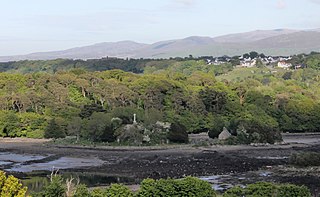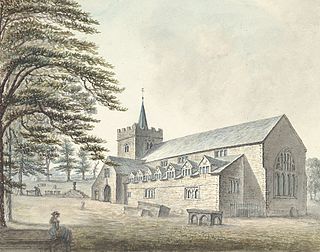
Geoffrey of Monmouth was a Catholic cleric from Monmouth, Wales, and one of the major figures in the development of British historiography and the popularity of tales of King Arthur. He is best known for his chronicle The History of the Kings of Britain which was widely popular in its day, being translated into other languages from its original Latin. It was given historical credence well into the 16th century, but is now considered historically unreliable.
Nennius is a mythical prince of Britain at the time of Julius Caesar's invasions of Britain. His story appears in Geoffrey of Monmouth's History of the Kings of Britain (1136), a work whose contents are now considered largely fictional. In Middle Welsh versions of Geoffrey's Historia he was called Nynniaw.

Meifod, formerly also written Meivod, is a small village, community and electoral ward 7 miles north-west of Welshpool in Montgomeryshire, Powys, Wales, on the A495 road and located in the valley of the River Vyrnwy. The River Banwy has a confluence with the Vyrnwy approximately two miles to the west of the village. The village itself had a population of 317. The community includes the village of Bwlch-y-cibau and the hamlet of Allt-y-Main.
Brochwel son of Cyngen, better known as Brochwel Ysgithrog, was a king of Powys in eastern Wales. The unusual epithet Ysgithrog has been translated as "of the canine teeth", "the fanged" or "of the tusk".
The Battle of Chester was a major victory for the Anglo-Saxons over the native Britons near the city of Chester, England in the early 7th century. Æthelfrith of Northumbria annihilated a combined force from the Welsh kingdoms of Powys and Rhôs, and possibly from Mercia as well. It resulted in the deaths of Welsh leaders Selyf Sarffgadau of Powys and Cadwal Crysban of Rhôs. Circumstantial evidence suggests that King Iago of Gwynedd may have also been killed. Other sources state the battle may have been in 613 or even as early as 607 or 605 AD.

Church Island, also known as Llandysilio Island, is a small island in the Menai Strait on the shores of Anglesey to which it is attached by a short causeway that is reachable only on foot. The dominant feature of the island is with St Tysilio's Church, constructed in the 15th century, its churchyard, and a grade-II listed war memorial. The 20th-century bard Cynan is among several notable people buried in the churchyard. The Anglesey Coastal Path passes the head of the causeway.
Llefelys is a character in Welsh mythology appearing in the medieval Welsh tale Cyfranc Lludd a Llefelys. In the tale, Llefelys is king of Gaul while his brother Lludd is king of Britain. The tale appears in the Red Book of Hergest and the White Book of Rhydderch, the source texts for the Mabinogion, and embedded into various versions of the Brut y Brenhinedd, the Welsh adaptation of Geoffrey of Monmouth's Historia Regum Britanniae.
Llan and its variants are a common element of Celtic placenames in the British Isles and Brittany, especially of Welsh toponymy. In Welsh the name of a local saint or a geomorphological description follows the Llan morpheme to form a single word: for example Llanfair is the parish or settlement around the church of St. Mair. Goidelic toponyms end in -lann.
Brenhinoedd y Saeson is the medieval title of three Middle Welsh annalistic chronicles known from three 14th-century manuscripts recording events from 682 to the English conquest of Wales in 1282. The title Brenhinoedd y Saeson is found only in the rubric to the earlier of the two surviving manuscripts of version S: the other two texts are commonly known as Brut y Tywysogion, but this title is found only in manuscripts of the late 16th century and cannot be considered authentic.

Llandysilio is a small village and community in Montgomeryshire, Powys, Wales.
Brynley Francis Roberts, known as Bryn Roberts, was a Welsh scholar and critic, who wrote significantly on the Welsh language and Celtic history. He was Professor of Welsh Language and Literature at the University of Wales, Swansea 1978–1985 and Librarian of the National Library of Wales in 1985–1994, then made editor of the Dictionary of Welsh Biography in 1987 and of Y Traethodydd in 1999. He was on the council of the Honourable Society of Cymmrodorion and involved in the Morfa Chapel, Aberystwyth, part of the Presbyterian Church of Wales. In 2011, he was elected as a Fellow of the Learned Society of Wales.

Brut y Brenhinedd is a collection of variant Middle Welsh versions of Geoffrey of Monmouth's Latin Historia Regum Britanniae. About 60 versions survive, with the earliest dating to the mid-13th century. Adaptations of Geoffrey's Historia were extremely popular throughout Western Europe during the Middle Ages, but the Brut proved especially influential in medieval Wales, where it was largely regarded as an accurate account of the early history of the Celtic Britons.

Lludd and Llefelys is a Middle Welsh prose tale written down in the 12th or 13th century; it was included in the Mabinogion by Lady Charlotte Guest in the 19th century. It tells of the Welsh hero Lludd Llaw Eraint, best known as King Lud son of Heli in Geoffrey of Monmouth's Historia Regum Britanniae, and his brother Llefelys.
Walter of Oxford was a cleric and writer. He served as archdeacon of Oxford in the 12th century. Walter was a friend of Geoffrey of Monmouth, who claimed he got his chief source for the Historia Regum Britanniae from him.
Saint Mechell was the 6th century founder and first abbot of the clas of Llanfechell, on Anglesey in north-west Wales. St Mechell's day is celebrated on 15 November. It is claimed that he is buried in Llanfechell.

Guilsfield is a village and local government community in Montgomeryshire, Powys, Wales. It lies beside Guilsfield Brook about three miles north of Welshpool. It is located on the B4392 road and a disused branch of the Montgomery Canal starts nearby. The community has an area of 30.01 km2 (11.59 sq mi) and had a population of 1,640 in 2001. rising to 1,727 in 2011. The community includes the villages of Burgedin and Groes-lwyd. The village itself had a population of about 1,220.

Bryneglwys is a village and community in Denbighshire, Wales. The village lies to the northeast of Corwen on a hill above a small river, Afon Morwynion, and is situated in the ancient commote of Iâl (Yale). The community covers an area of 9.45 square miles (24.5 km2) and extends to the top of Llantysilio Mountain. It had a population of 369 at the time of the 2011 census, an increase from 344 during the 2001 census.

Saint Aelhaiarn or Aelhaearn was a Welsh confessor and saint of the British Church. He was a disciple of Saint Beuno. His feast day was usually observed on 2 November, although it is sometimes recorded as the 1st and is no longer observed by either the Anglican or Catholic church in Wales.

St Tysilio's Church is a medieval church in the village of Menai Bridge, Anglesey, Wales. The current building dates from the early 15th century and underwent renovations in the 19th century. It was designated as a Grade II* listed building on 14 February 1967.
Gwyddfarch was a hermit and founder of a Celtic abbey at Meifod in Wales. He was a son of Amalarius and disciple of St. Llywelyn at Welshpool. About 550 AD he founded a monastery at Meifod. This establishment became the mother church of several other monasteries and was a centre of the order for over one thousand years, and within a generation the monastery had become a centre of pilgrimage.










